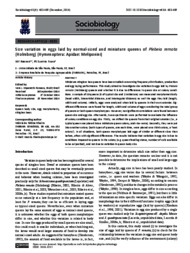Size variation in eggs laid by normal-sized and miniature queens of Plebeia remota (Holmberg) (Hymenoptera: Apidae: Meliponini).
Size variation in eggs laid by normal-sized and miniature queens of Plebeia remota (Holmberg) (Hymenoptera: Apidae: Meliponini).
Author(s): RIBEIRO, M. de F.; SANTOS FILHO, P. S.
Summary: Miniature stingless bee queens have been studied concerning frequency distribution, production and egg laying performance. This study aimed to investigate size variation in eggs laid by Plebeia remota (Holmberg) queens and whether it is due to differences in queen size or colony conditions. A sample of 10 queens (8 of typical size and 2 miniature) was measured morphometrically (head width, interorbital distance, and intertegular distance) as well the eggs they laid (length, width and volume). Initially, eggs were analyzed when laid by queens in their own colonies. Significant differences were found for length, width and volume of eggs considering the total group of queens or both queen morphotypes. However, no significant correlations were found between queen size and egg size. Afterwards, two experiments were performed to evaluate the influence of colony conditions on egg size. Firstly, we shifted the queens from their original colonies (i.e., a typical queen was placed into a miniature queen colony, and vice-versa). Secondly, they were put into another colony (both types of queens, one each time, were placed on a third colony, a ?host colony?). In all situations, both queen morphotypes laid eggs of similar or different sizes than before, often with significant differences. The results indicate that variation in egg size is due to conditions imposed to queens in the colony (e.g. queen feeding status, number of cells available to be oviposited), and not due to variation in queen body size.
Publication year: 2014
Types of publication: Journal article
Unit: Embrapa Semi-arid Region
Keywords: Abelha, Abelhas sem ferrão, Insect, Inseto
Observation
Some of Embrapa's publications are published as ePub files. To read them, use or download one of the following free software options to your computer or mobile device. Android: Google Play Books; IOS: iBooks; Windows and Linux: Calibre.
Access other publications
Access the Agricultural Research Database (BDPA) to consult Embrapa's full library collection and records.
Visit Embrapa Bookstore to purchase books and other publications sold by Embrapa.

